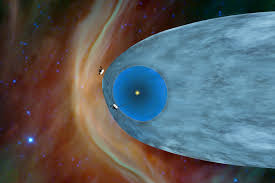Voyager 1 Sends Mysterious Data To Earth That Shocks Scientists

NASA engineers are investigating a mystery with telemetry data from the aging Voyager 1 probe.
The Voyager 1 probe, currently 14.5 billion miles from Earth, is receiving and executing commands from the NASA team on Earth and sending back science data, according to a NASA statement.
Voyager 1, which launched in 1977, is some 14.5 billion miles (23 billion km) from Earth. Scientists say it’s beyond our solar system, in interstellar space. The 45-year-old probe has been a model of endurance, continuing to send back data using decades-old technology. But on May 18, 2022, NASA announced that Voyager 1 has been sending back mysterious data. The probe’s attitude articulation and control system (its AACS) has the job of controlling the spacecraft’s orientation, pointing its high gain antenna toward Earth, and controlling attitude maneuvers. Now the AACS has sent back data that doesn’t reflect what’s happening aboard Voyager. NASA explained:

… the data may appear to be randomly generated or does not reflect any possible state the AACS could be in.
A 2-day round trip message time
For the most part, Voyager 1 still appears to be working correctly, gathering and returning science data. It’s receiving and executing commands from Earth, although – because of its great distance from us – it takes about two days to send a message and get a response. Because we’re still in communication with Voyager 1, we know the antenna is still pointing toward us, regardless of the strange nature of the telemetry data readings.
NASA said:
The team will continue to monitor the signal closely as it continues to determine whether the invalid data is coming directly from the AACS or another system involved in producing and sending telemetry data. Until the nature of the issue is better understood, the team cannot anticipate whether this might affect how long the spacecraft can collect and transmit science data.

Communicating with interstellar space
Voyager 1 is the most distant human-made object from Earth. Working with a system that is so far away – and that was designed so many decades ago – presents many challenges, beyond just the lag in communications. Suzanne Dodd, project manager for Voyager 1 and 2, commented:
A mystery like this is sort of par for the course at this stage of the Voyager mission. The spacecraft are both almost 45 years old, which is far beyond what the mission planners anticipated. We’re also in interstellar space: a high-radiation environment that no spacecraft have flown in before. So there are some big challenges for the engineering team. But I think if there’s a way to solve this issue with the AACS, our team will find it.

EarthSky
Subscribe
Space
Voyager 1 mystery: Sending random data
Posted by
Kelly Kizer Whitt

May 19, 2022

Artist’s concept of the robot spacecraft Voyager 1. Some call it and its companion craft, Voyager 2, the little spacecraft that could. Launched from Earth in 1977, the pair is beyond the sphere of our sun’s influence, still heading outward. But now Voyager 1 has started sending back mystery data. Image via NASA.
Mysterious data from Voyager 1
Voyager 1, which launched in 1977, is some 14.5 billion miles (23 billion km) from Earth. Scientists say it’s beyond our solar system, in interstellar space. The 45-year-old probe has been a model of endurance, continuing to send back data using decades-old technology. But on May 18, 2022, NASA announced that Voyager 1 has been sending back mysterious data. The probe’s attitude articulation and control system (its AACS) has the job of controlling the spacecraft’s orientation, pointing its high gain antenna toward Earth, and controlling attitude maneuvers. Now the AACS has sent back data that doesn’t reflect what’s happening aboard Voyager. NASA explained:
… the data may appear to be randomly generated or does not reflect any possible state the AACS could be in.

Voyager 1 is said to have sailed out of our solar system in 2012 when it crossed the heliopause – or boundary of our sun’s influence – into interstellar space. Image via NASA.
A 2-day round trip message time
For the most part, Voyager 1 still appears to be working correctly, gathering and returning science data. It’s receiving and executing commands from Earth, although – because of its great distance from us – it takes about two days to send a message and get a response. Because we’re still in communication with Voyager 1, we know the antenna is still pointing toward us, regardless of the strange nature of the telemetry data readings.
NASA said:
The team will continue to monitor the signal closely as it continues to determine whether the invalid data is coming directly from the AACS or another system involved in producing and sending telemetry data. Until the nature of the issue is better understood, the team cannot anticipate whether this might affect how long the spacecraft can collect and transmit science data.

Voyager 1 is vastly too faint to see, even with the most powerful earthly telescopes. But – if we could see it – on May 19, 2022, we’d find it in the direction of the constellation of Ophiuchus the Serpent Bearer, which is ascending into our sky before midnight at this time of the year, and high in the sky around dawn. Image via TheSkyLive.
Communicating with interstellar space
Voyager 1 is the most distant human-made object from Earth. Working with a system that is so far away – and that was designed so many decades ago – presents many challenges, beyond just the lag in communications. Suzanne Dodd, project manager for Voyager 1 and 2, commented:
A mystery like this is sort of par for the course at this stage of the Voyager mission. The spacecraft are both almost 45 years old, which is far beyond what the mission planners anticipated. We’re also in interstellar space: a high-radiation environment that no spacecraft have flown in before. So there are some big challenges for the engineering team. But I think if there’s a way to solve this issue with the AACS, our team will find it.
Once the team finds the source of the problem, engineers might be able to solve the issue through software changes, or by using one of the spacecraft’s redundant hardware systems. But if they can’t find the source of the problem, they might just have to adapt to living with the discrepancies.
Voyager 1’s journey has encountered obstacles before. In 2017, the spacecraft’s primary thrusters were showing signs of wear and tear. The engineers switched to other thrusters on Voyager 1, thrusters that operated during the mission’s planetary encounters some 37 years earlier. It’s another example of the remarkable longevity and ingenious design of the Voyager spacecraft.
Source
NASA

 My First News Item
My First News Item My Nine News Item
My Nine News Item